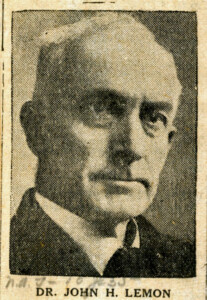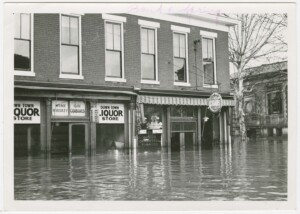
Since its founding, New Albany has seen a lot of change. Buildings are built and renovated, people and businesses come and go, but perhaps some things never leave. Walk in the same shoes as people who lived from the 1800s to the early 1900s as you travel back in time during this historic self-guided ghost walk/drive. While you read these stories, try to imagine what people experiencing them would have done in a day, what their New Albany looked like, what they dressed like, and what they ate for dinner. How are you similar? How is your life different? Allow your imagination to transport you back to a time not so unconnected to our own. Happy hunting!
Note: The addresses mentioned are not residential or the homes no longer exist, but please be respectful of businesses and their patrons while you visit these locations. Also, if walking at night make sure that you are aware of your surroundings at all times to ensure your safety.
218 W Main Street
On Main Street in New Albany, almost underneath interstate 64, there used to be a house where a family experienced tragedies that literally “tore them to pieces.” The Marrs family consisted of father Officer John Sr., mother Belle, and sons Richard, Harry, and John Jr. One crisp October 31st in 1885, eldest son Richard was making his way home from a Halloween party. For some unknown reason, Richard attempted to shorten his commute home by jumping onto a train that was moving towards his family’s home at 218 W Main. Richard lost his footing and fell headfirst onto the tracks. The train crushed his body until it was almost unrecognizable. The family was understandably shocked and horrified, comforted some by the fact that he broke his neck upon impact with the tracks and hopefully did not suffer. They buried Richard at Fairview Cemetery, Plot 2, Range 14, Lot 26.
Years passed and the family moved out of mourning, picked up the pieces of their lives, and attempted to move past the horrifying death of the oldest child. By some strange fate though, on September 29, 1887, misfortune struck the Marrs Family again. John Jr. was walking with friends along the tracks of the Louisville, New Albany, & Ohio railroad, on their way to play baseball on the east side of town. A train appeared on the tracks, and John Jr. attempted to jump on board. Similar to his brother, the boy lost his footing, but instead of landing head first, he twisted and his legs ended up under the train and were swiftly cut off his body. For several minutes the boy was cognizant enough to respond to questions until he finally closed his eyes and died due to loss of blood. John Jr. was buried next to his brother. The boys’ mother would die, possibly from a broken heart, in the following years and be buried next to her sons. Officer John Sr. remarried and moved away from New Albany with his new bride and only living son.
217 Pearl Street
Dr. John H. Lemon was a highly accomplished physician, ethnologist, and geologist, who experienced several phantom occurrences in downtown New Albany. Many of his experiences were published in the New Albany Tribune due to his local credibility within the community.
Dr. Lemon was acquainted with Mrs. Lydia Towner when he first moved to New Albany in 1867 and she became one of his patients. The widow, who had lost her husband Joseph Towner in 1855, and followed by a constant rapping, everywhere she went. Dr. Lemon experienced this rapping one night when he hosted Lydia at his then home on Pearl Street, which has been replaced by many different buildings since that night. When everyone sat down for dinner, and food was being passed, there were several brisk raps on Lydia’s chair back and down the sides. Dr. Lemon said “Lydia, your friends have come with you. They are very welcome.” To which she replied “That is Joseph. He is glad I have so much to eat.”
Dr. Lemon would often see Lydia on the street or in his office and exchange common pleasantries, but he saw her for the last time when a messenger asked him to her house to help her in her dying moments. When Dr. Lemon arrived and raps rang out from Lydia’s chair and she stated that “it is Joseph. He is glad you have come.” Dr. Lemon gave Lydia an elixir of hot water, whiskey, paregoric, and ginger, and stayed with her while her attendant finished dinner. Dr. Lemon opened Lydia’s front door to allow her to look out on green grass and fields of corn near the Ohio River and West of Louisville for a final time. Lydia said faintly “My life has been lonely and often hard to get along, especially in winter, but I have not been unhappy. I am glad now.” Dr. Lemon closed the front door and heard on the solid cherry table three heavy solemn knocks which he described as almost saying “This is all, it is finished.” Dr. Lemon and Lydia waited in silence until her attendant returned, and Dr. Lemon went home. Lydia died that night.
Note from Dr. Lemon about this story: “I have related everything connected with these manifestations of the supernatural, the most definite in a very long medical experience.”

Dr. John H. Lemon
East Bank Street and East Spring Street
At the corner of Bank and Spring streets, Dr. Lemon occupied a house that he used as an office for patients and part living quarters on the second level. The building belonged to Jacob Murphy and was divided into two sections, Dr. Lemon occupied the Spring Street side, and Jacob Murphy and his wife Lillie on the other. While Dr. Lemon lived in this house, Mr. Murphy passed and had his coffin placed in his downstairs parlor for a time while his body awaited the funeral. Following her husband’s funeral, Lillie Murphy went to stay with cousins in Greenville, and the home was empty except for Dr. Lemon.
A week after the funeral, Dr. Lemon was up late going over his accounts books downstairs, which he preferred to do after working hours to escape interruption. By midnight he had been sitting for hours in silence, except for the turning of his pages, illuminated by the flickering of his coal oil lamp and candle. Suddenly he heard slow hesitant footsteps eight feet above him upstairs. He instantly thought that this was an intruder and must have malicious intent. In the same slow careful manner, the steps descended Dr. Lemon’s staircase and stopped just short of the closed door that connected the upstairs and downstairs. Dr. Lemon quietly took his pistol out of his desk drawer and opened his front door. He then carefully opened the stair door, readying himself for what lay in wait behind.
To his surprise, the stairs were vacant, and he called out “Come on down and go away” several times with no response. He told the stranger that “the way out is clear, come down and go out, and you won’t be hurt,” but still no response. He was confused, since he had not heard the footsteps go back upstairs, but assumed that must be where the intruder had gone. Dr. Lemon armed himself with a stove poker as an additional weapon and ascended the stairs to search for the intruder. After checking under furniture, and in every other location, the last resort was the large built-in closet in his upstairs bedroom. He flung open the doors expecting to fight, but the closet was empty.
It was then that Dr. Lemon realized his friend and neighbor Jacob Murphy had paid him a visit.

Jacob Murphy’s home during the 1937 flood.
East Fifth Street and East Spring Street
Sophia Scharf died on December 2, 1891, in her home at the corner of Fifth and Spring streets. A few days following the funeral, Sophia’s daughter-in-law visited the house and was terribly frightened by Sophia’s face looking at her through the front window. The likeness to the old woman was uncanny, it looked exactly like the deceased. The image remained on the front window for a week and then vanished. Many had moved past the image until it appeared as suddenly as it had vanished, starting dimly at first and becoming more distinct with every day. Many attempts were made to try and wash the image off the window, but no one could scrub the window free of the woman’s face. Many weeks after the funeral, Mrs. Scharf’s son who lived in California, and had not made it in time to attend the funeral, used his handkerchief to gently wipe the window clean, and the image never appeared again.
Sources:
Seidle, Gregg (2011) Wicked New Albany. The History Press. Charleston, SC.
U.S. Census Bureau (1870). United States Federal Census.
Lemon, John H. (circa 1882) New Albany Tribune.
Edwards, Frank (1983). Stranger Than Science. Pg. 186
Lemon, John H. (1928, August 23). New Albany Tribune.
